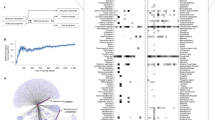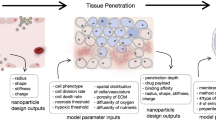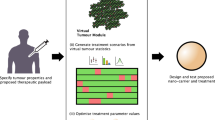Abstract
Owing to their distinct physical and chemical properties, inorganic nanoparticles (NPs) have shown promising results in preclinical cancer therapy, but designing and engineering them for effective therapeutic purposes remains a challenge. Although a comprehensive database of inorganic NP research is not currently available, it is crucial for developing effective cancer therapies. In this context, machine learning (ML) has emerged as a transformative tool, but its adaptation to nanomedicine is hindered by inexistent or small datasets. Here we assembled a large database of inorganic NPs, comprising experimental datasets from 745 preclinical studies in cancer nanomedicine. Using descriptive statistics and explainable ML models we mined this database to gain knowledge of inorganic NP design patterns and inform future NP research for cancer treatment. Our analyses suggest that NP shape and therapy type are prominent features in determining in vivo efficacy, measured as a percentage of tumour reduction. Moreover, our database provides a large-scale open-access resource for discriminative ML that the broader nanotechnology community can utilize. Our work blueprints data mining for translational cancer research and offers evidence for standardizing NP reporting to accelerate and de-risk inorganic NP-based drug delivery, which may help to improve patient outcomes in clinical settings.
This is a preview of subscription content, access via your institution
Access options
Access Nature and 54 other Nature Portfolio journals
Get Nature+, our best-value online-access subscription
$29.99 / 30 days
cancel any time
Subscribe to this journal
Receive 12 print issues and online access
$259.00 per year
only $21.58 per issue
Buy this article
- Purchase on Springer Link
- Instant access to full article PDF
Prices may be subject to local taxes which are calculated during checkout






Similar content being viewed by others
Data availability
The full database is publicly available via GitHub at https://github.com/RekerLab/NanoAnalysis. Source data are provided with this paper.
Code availability
The code to create our machine learning models and perform the analysis described here is publicly available via GitHub at https://github.com/RekerLab/NanoAnalysis.
References
Mendes, B. B., Sousa, D. P., Conniot, J. & Conde, J. Nanomedicine-based strategies to target and modulate the tumor microenvironment. Trends Cancer 7, 847–862 (2021).
Bobo, D., Robinson, K. J., Islam, J., Thurecht, K. J. & Corrie, S. R. Nanoparticle-based medicines: a review of FDA-approved materials and clinical trials to date. Pharm. Res. 33, 2373–2387 (2016).
Anselmo, A. C. & Mitragotri, S. Nanoparticles in the clinic: an update. Bioeng. Transl. Med. 4, e10143 (2019).
Anselmo, A. C. & Mitragotri, S. Nanoparticles in the clinic: an update post COVID-19 vaccines. Bioeng. Transl. Med. 6, e10246 (2021).
Mendes, B. B. et al. Nanodelivery of nucleic acids. Nat. Rev. Methods Primers 2, 24 (2022).
van der Meel, R. et al. Smart cancer nanomedicine. Nat. Nanotechnol. 14, 1007–1017 (2019).
Janjua, T. I., Cao, Y., Yu, C. & Popat, A. Clinical translation of silica nanoparticles. Nat. Rev. Mater. 6, 1072–1074 (2021).
Das, C. G. A., Kumar, V. G., Dhas, T. S., Karthick, V. & Kumar, C. M. V. Nanomaterials in anticancer applications and their mechanism of action - a review. Nanomedicine 47, 102613 (2023).
Gavas, S., Quazi, S. & Karpiński, T. M. Nanoparticles for cancer therapy: current progress and challenges. Nanoscale Res. Lett. 16, 173 (2021).
Faria, M., Björnmalm, M., Crampin, E. J. & Caruso, F. A few clarifications on MIRIBEL. Nat. Nanotechnol. 15, 2–3 (2020).
Faria, M. et al. Minimum information reporting in bio–nano experimental literature. Nat. Nanotechnol. 13, 777–785 (2018).
Lorenc, A. et al. Machine learning for next-generation nanotechnology in healthcare. Matter 4, 3078–3080 (2021).
Mitchell, M. J. et al. Engineering precision nanoparticles for drug delivery. Nat. Rev. Drug Discov. 20, 101–124 (2021).
Boehnke, N. et al. Massively parallel pooled screening reveals genomic determinants of nanoparticle delivery. Science 377, eabm5551 (2023).
Brockow, K. et al. Experience with polyethylene glycol allergy-guided risk management for COVID-19 vaccine anaphylaxis. Allergy 77, 2200–2210 (2022).
Sellaturay, P., Nasser, S., Islam, S., Gurugama, P. & Ewan, P. W. Polyethylene glycol (PEG) is a cause of anaphylaxis to the Pfizer/BioNTech mRNA COVID-19 vaccine. Clin. Exp. Allergy 51, 861–863 (2021).
Stone, C. A. Jr. et al. Immediate hypersensitivity to polyethylene glycols and polysorbates: more common than we have recognized. J. Allergy Clin. Immunol. Pract. 7, 1533–1540.e8 (2019).
Chenthamara, D. et al. Therapeutic efficacy of nanoparticles and routes of administration. Biomater. Res. 23, 20 (2019).
Sung, H. et al. Global cancer statistics 2020: GLOBOCAN estimates of incidence and mortality worldwide for 36 cancers in 185 countries. CA Cancer J. Clin. 71, 209–249 (2021).
Global Burden of Disease 2019 Cancer Collaboration. Cancer incidence, mortality, years of life lost, years lived with disability, and disability-adjusted life years for 29 cancer groups from 2010 to 2019: a systematic analysis for the Global Burden of Disease Study 2019. JAMA Oncol. 8, 420–444 (2022).
Alvarez, E. M. et al. The global burden of adolescent and young adult cancer in 2019: a systematic analysis for the Global Burden of Disease Study 2019. Lancet Oncol. 23, 27–52 (2022).
Chen, Y., Chen, H. & Shi, J. In vivo bio-safety evaluations and diagnostic/therapeutic applications of chemically designed mesoporous silica nanoparticles. Adv. Mater. 25, 3144–3176 (2013).
Iscaro, A., Howard, F. N. & Muthana, M. Nanoparticles: properties and applications in cancer immunotherapy. Curr. Pharm. Des. 25, 1962–1979 (2019).
Zhou, H. et al. Biodegradable inorganic nanoparticles for cancer theranostics: insights into the degradation behavior. Bioconjug. Chem. 31, 315–331 (2020).
Zhang, Y. et al. Prolonged local in vivo delivery of stimuli-responsive nanogels that rapidly release doxorubicin in triple-negative breast cancer cells. Adv. Healthc. Mater. 9, 1901101 (2020).
Conde, J., Oliva, N., Zhang, Y. & Artzi, N. Local triple-combination therapy results in tumour regression and prevents recurrence in a colon cancer model. Nat. Mater. 15, 1128–1138 (2016).
Kwong, B., Gai, S. A., Elkhader, J., Wittrup, K. D. & Irvine, D. J. Localized immunotherapy via liposome-anchored anti-CD137 + IL-2 prevents lethal toxicity and elicits local and systemic antitumor immunity. Cancer Res. 73, 1547–1558 (2013).
Li, W. et al. Hyaluronic acid ion-pairing nanoparticles for targeted tumor therapy. J. Control. Release 225, 170–182 (2016).
Lei, C. et al. Local release of highly loaded antibodies from functionalized nanoporous support for cancer immunotherapy. J. Am. Chem. Soc. 132, 6906–6907 (2010).
Fransen, M. F., van der Sluis, T. C., Ossendorp, F., Arens, R. & Melief, C. J. M. Controlled local delivery of CTLA-4 blocking antibody induces CD8+ T-cell-dependent tumor eradication and decreases risk of toxic side effects. Clin. Cancer Res. 19, 5381–5389 (2013).
Ishihara, J. et al. Matrix-binding checkpoint immunotherapies enhance antitumor efficacy and reduce adverse events. Sci. Transl. Med. 9, eaan0401 (2017).
Errington, T. M., Denis, A., Perfito, N., Iorns, E. & Nosek, B. A. Challenges for assessing replicability in preclinical cancer biology. eLife 10, e67995 (2021).
Wilhelm, S. et al. Analysis of nanoparticle delivery to tumours. Nat. Rev. Mater. 1, 16014 (2016).
Cheng, Y.-H., He, C., Riviere, J. E., Monteiro-Riviere, N. A. & Lin, Z. Meta-analysis of nanoparticle delivery to tumors using a physiologically based pharmacokinetic modeling and simulation approach. ACS Nano 14, 3075–3095 (2020).
Zhong, R. et al. Hydrogels for RNA delivery. Nat. Mater. https://doi.org/10.1038/s41563-023-01472-w (2023).
Lasagna-Reeves, C. et al. Bioaccumulation and toxicity of gold nanoparticles after repeated administration in mice. Biochem. Biophys. Res. Commun. 393, 649–655 (2010).
Hatakeyama, H., Akita, H. & Harashima, H. A multifunctional envelope type nano device (MEND) for gene delivery to tumours based on the EPR effect: a strategy for overcoming the PEG dilemma. Adv. Drug Deliv. Rev. 63, 152–160 (2011).
Harris, J. M., Martin, N. E. & Modi, M. Pegylation. Clin. Pharmacokinet. 40, 539–551 (2001).
Suk, J. S., Xu, Q., Kim, N., Hanes, J. & Ensign, L. M. PEGylation as a strategy for improving nanoparticle-based drug and gene delivery. Adv. Drug Deliv. Rev. 99, 28–51 (2016).
Zhang, M. et al. Influencing factors and strategies of enhancing nanoparticles into tumors in vivo. Acta Pharm. Sin. B 11, 2265–2285 (2021).
Nguyen, L. N. M. et al. The exit of nanoparticles from solid tumours. Nat. Mater. 22, 1261–1272 (2023).
Setyawati, M. I. et al. Titanium dioxide nanomaterials cause endothelial cell leakiness by disrupting the homophilic interaction of VE–cadherin. Nat. Commun. 4, 1673 (2013).
Shamay, Y. et al. Quantitative self-assembly prediction yields targeted nanomedicines. Nat. Mater. 17, 361–368 (2018).
Reker, D. et al. Computationally guided high-throughput design of self-assembling drug nanoparticles. Nat. Nanotechnol. 16, 725–733 (2021).
Bannigan, P. et al. Machine learning models to accelerate the design of polymeric long-acting injectables. Nat. Commun. 14, 35 (2023).
Lundberg, S. M. et al. From local explanations to global understanding with explainable AI for trees. Nat. Mach. Intell. 2, 56–67 (2020).
Caballero, D. et al. Precision biomaterials in cancer theranostics and modelling. Biomaterials 280, 121299 (2022).
Zhao, Y. et al. A comparison between sphere and rod nanoparticles regarding their in vivo biological behavior and pharmacokinetics. Sci. Rep. 7, 4131 (2017).
Kolhar, P. et al. Using shape effects to target antibody-coated nanoparticles to lung and brain endothelium. Proc. Natl Acad. Sci. USA 110, 10753–10758 (2013).
Zhang, M., Kim, H. S., Jin, T. & Moon, W. K. Near-infrared photothermal therapy using EGFR-targeted gold nanoparticles increases autophagic cell death in breast cancer. J. Photochem. Photobiol. B 170, 58–64 (2017).
Jo, Y. et al. Chemoresistance of cancer cells: requirements of tumor microenvironment-mimicking in vitro models in anti-cancer drug development. Theranostics 8, 5259–5275 (2018).
Guo, B. et al. Molecular engineering of conjugated polymers for biocompatible organic nanoparticles with highly efficient photoacoustic and photothermal performance in cancer theranostics. ACS Nano 11, 10124–10134 (2017).
Li, Z. et al. Small gold nanorods laden macrophages for enhanced tumor coverage in photothermal therapy. Biomaterials 74, 144–154 (2016).
Das, P., Delost, M. D., Qureshi, M. H., Smith, D. T. & Njardarson, J. T. A survey of the structures of US FDA approved combination drugs. J. Med. Chem. 62, 4265–4311 (2019).
Fernandes Neto, J. M. et al. Multiple low dose therapy as an effective strategy to treat EGFR inhibitor-resistant NSCLC tumours. Nat. Commun. 11, 3157 (2020).
Kim, M. H. et al. The effect of VEGF on the myogenic differentiation of adipose tissue derived stem cells within thermosensitive hydrogel matrices. Biomaterials 31, 1213–1218 (2010).
Pedregosa, F. et al. Scikit-learn: machine learning in Python. J. Mach. Learn. Res. 12, 2825–2830 (2011).
Chen, T. & Guestrin, C. XGBoost: a scalable tree boosting system. in Proc. of the 22nd ACM SIGKDD International Conference on Knowledge Discovery and Data Mining 785–794 (Association for Computing Machinery, 2016).
Lundberg, S. M. & Lee, S.-I. A unified approach to interpreting model predictions. in Advances in Neural Information Processing Systems (eds Guyon, I. et al.) Vol. 30 (Curran Associates, Inc., 2017).
Acknowledgements
This project received funding from the European Research Council (ERC) under the European Union’s Horizon 2020 research and innovation programme (ERC-StG-2019-848325), the Duke Science and Technology Initiative and the National Institutes of Health NIGMS grant R35GM151255. We acknowledge Fundação para a Ciência e a Tecnologia (FCT) for financial support in the framework of the PhD grant 2020.06638.BD (D.P.S.), the Duke Department of Biomedical Engineering for support through a BME Fellowship (Z.Z.), the National Science Foundation (NSF) for support through the Graduate Research Fellowship DGE2129754 (L.A.O.) and the ERASMUS+ programme (A.L.).
Author information
Authors and Affiliations
Contributions
J. Conde conceived the idea and concept of the study. D.R. conceived the ML platform. T.R. conceived the data curation. B.B.M., J. Conniot, D.P.S., J.M.J.M.R. and J. Conde collected all of the data from the published manuscripts, organized the dataset and calculated the correlations. Z.Z., L.A.O. and A.L. conducted the data analysis, text mining and designed, implemented and evaluated the ML models. J. Conde, D.R. and T.R provided guidance and supervised the work. All authors contributed to the writing and editing of the paper, and all authors approved the final version of the paper.
Corresponding authors
Ethics declarations
Competing interests
J. Conde and T.R. are co-founders and shareholders of TargTex SA Targeted Therapeutics for Glioblastoma Multiforme. J. Conde is a member of the Global Burden of Disease (GBD) consortium from the Institute for Health Metrics and Evaluation (IHME), University of Washington, USA, and member of the Scientific Advisory Board of Vector Bioscience, Cambridge. T.R. acts as a consultant to the pharmaceutical, biotechnology and technology industry and is a full member of the Acceleration Consortium, University of Toronto. D.R. acts as a consultant to the pharmaceutical and biotechnology industry, as a scientific mentor for Start2 and serves on the scientific advisory board of Areteia Therapeutics. The other authors declare no competing interests.
Peer review
Peer review information
Nature Nanotechnology thanks Natalie Boehnke, Karolina Jagiełło and the other, anonymous, reviewer(s) for their contribution to the peer review of this work.
Additional information
Publisher’s note Springer Nature remains neutral with regard to jurisdictional claims in published maps and institutional affiliations.
Supplementary information
Supplementary Information
Supplementary Results and Discussion, Figs. 1– 9, Tables 1–8 and Refs. 1–11.
Source data
Source Data Fig. 2
Alluvial plot source data for Fig. 2c.
Source Data Fig. 4
Raw data for Fig. 4d, alluvial plot source data for Fig. 4e and statistical source data for Fig. 4f.
Rights and permissions
Springer Nature or its licensor (e.g. a society or other partner) holds exclusive rights to this article under a publishing agreement with the author(s) or other rightsholder(s); author self-archiving of the accepted manuscript version of this article is solely governed by the terms of such publishing agreement and applicable law.
About this article
Cite this article
Mendes, B.B., Zhang, Z., Conniot, J. et al. A large-scale machine learning analysis of inorganic nanoparticles in preclinical cancer research. Nat. Nanotechnol. (2024). https://doi.org/10.1038/s41565-024-01673-7
Received:
Accepted:
Published:
DOI: https://doi.org/10.1038/s41565-024-01673-7



